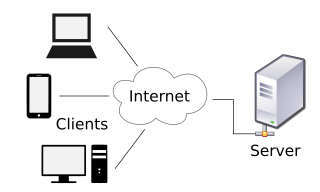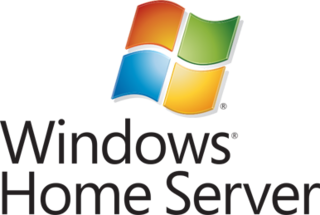
The client–server model is a distributed application structure that partitions tasks or workloads between the providers of a resource or service, called servers, and service requesters, called clients. Often clients and servers communicate over a computer network on separate hardware, but both client and server may reside in the same system. A server host runs one or more server programs, which share their resources with clients. A client usually does not share any of its resources, but it requests content or service from a server. Clients, therefore, initiate communication sessions with servers, which await incoming requests. Examples of computer applications that use the client–server model are email, network printing, and the World Wide Web.

The X Window System is a windowing system for bitmap displays, common on Unix-like operating systems.

Bonjour is Apple's implementation of zero-configuration networking (zeroconf), a group of technologies that includes service discovery, address assignment, and hostname resolution. Bonjour locates devices such as printers, other computers, and the services that those devices offer on a local network using multicast Domain Name System (mDNS) service records.
WinGate is an integrated multi-protocol proxy server, email server and internet gateway from Qbik New Zealand Limited in Auckland. It was first released in October 1995, and began as a re-write of SocketSet, a product that had been previously released in prototype form by Adrien de Croy.
FlexNet Publisher is a software license manager from Flexera Software which implements license management and is intended to be used in corporate environments to provide floating licenses to multiple end users of computer software.
Traitor tracing schemes help trace the source of leaks when secret or proprietary data is sold to many customers. In a traitor tracing scheme, each customer is given a different personal decryption key. (Traitor tracing schemes are often combined with conditional access systems so that, once the traitor tracing algorithm identifies a personal decryption key associated with the leak, the content distributor can revoke that personal decryption key, allowing honest customers to continue to watch pay television while the traitor and all the unauthorized users using the traitor's personal decryption key are cut off.)

Windows Server Update Services (WSUS), previously known as Software Update Services (SUS), is a computer program and network service developed by Microsoft Corporation that enables administrators to manage the distribution of updates and hotfixes released for Microsoft products to computers in a corporate environment. WSUS downloads these updates from the Microsoft Update website and then distributes them to computers on a network. WSUS is an integral component of Windows Server.
In software licensing, volume licensing is the practice of using one license to authorize software on a large number of computers and/or for a large number of users. Customers of such licensing schemes are typically business, governmental or educational institutions, with prices for volume licensing varying depending on the type, quantity and applicable subscription-term. For example, Microsoft software available through volume-licensing programs includes Microsoft Windows and Microsoft Office.
A client access license (CAL) is a commercial software license that allows client computers to use server software services. Most commercial desktop apps are licensed so that payment is required for each installation, but some server products can be licensed so that payment is required for each device or user that accesses the service provided by the software. For example, an instance of Windows Server 2016 for which ten User CALs are purchased allows 10 distinct users to access the server.
A network host is a computer or other device connected to a computer network. A host may work as a server offering information resources, services, and applications to users or other hosts on the network. Hosts are assigned at least one network address.

Windows Home Server is a home server operating system from Microsoft. It was announced on 7 January 2007 at the Consumer Electronics Show by Bill Gates, released to manufacturing on 16 July 2007 and officially released on 4 November 2007.
LinuxMCE is a free and open source software platform with a 10-foot user interface designed to allow a computer to act as a home theater PC (HTPC) for the living-room TV, personal video recorder, and home automation system. It allows control of everything in the home, from lighting and climate to surveillance cameras and home security. It also includes a full-featured VoIP-compatible phone system with support for video conferencing.
In computing, the term remote desktop refers to a software- or operating system feature that allows a personal computer's desktop environment to be run remotely from one system, while being displayed on a separate client device. Remote desktop applications have varying features. Some allow attaching to an existing user's session and "remote controlling", either displaying the remote control session or blanking the screen. Taking over a desktop remotely is a form of remote administration.
Remote Desktop Services (RDS), known as Terminal Services in Windows Server 2008 and earlier, is one of the components of Microsoft Windows that allow a user to initiate and control an interactive session on a remote computer or virtual machine over a network connection. RDS was first released in 1998 as Terminal Server in Windows NT 4.0 Terminal Server Edition, a stand-alone edition of Windows NT 4.0 Server that allowed users to log in remotely. Starting with Windows 2000, it was integrated under the name of Terminal Services as an optional component in the server editions of the Windows NT family of operating systems, receiving updates and improvements with each version of Windows. Terminal Services were then renamed to Remote Desktop Services with Windows Server 2008 R2 in 2009.
In computing, virtualization or virtualisation is the act of creating a virtual version of something at the same abstraction level, including virtual computer hardware platforms, storage devices, and computer network resources.
Rocrail is a freeware software package for controlling a model train layout from one or more computers. Users can run trains directly from a computer, or have some run automatically with manual control for any others.
Floating licensing, also known as concurrent licensing or network licensing, is a software licensing approach in which a limited number of licenses for a software application are shared among a larger number of users over time. When an authorized user wishes to run the application, they request a license from a central license server. If a license is available, the license server allows the application to run. When they finish using the application, or when the allowed license period expires, the license is reclaimed by the license server and made available to other authorized users.
ConnectWise Control, previously Screenconnect, is a self-hosted remote desktop software application. It was originally developed by Elsinore Technologies in 2008 under the name ScreenConnect, and is now owned by ConnectWise Inc.

Microsoft Product Activation is a DRM technology used by Microsoft Corporation in several of its computer software programs, most notably its Windows operating system and its Office productivity suite. The procedure enforces compliance with the program's end-user license agreement by transmitting information about both the product key used to install the program and the user's computer hardware to Microsoft, inhibiting or completely preventing the use of the program until the validity of its license is confirmed.

SoftEther VPN is free open-source, cross-platform, multi-protocol VPN client and VPN server software, developed as part of Daiyuu Nobori's master's thesis research at the University of Tsukuba. VPN protocols such as SSL VPN, L2TP/IPsec, OpenVPN, and Microsoft Secure Socket Tunneling Protocol are provided in a single VPN server. It was released using the GPLv2 license on January 4, 2014. The license was switched to Apache License 2.0 on January 21, 2019.






